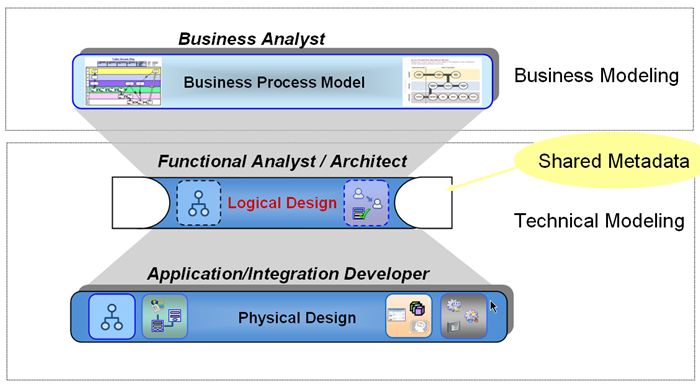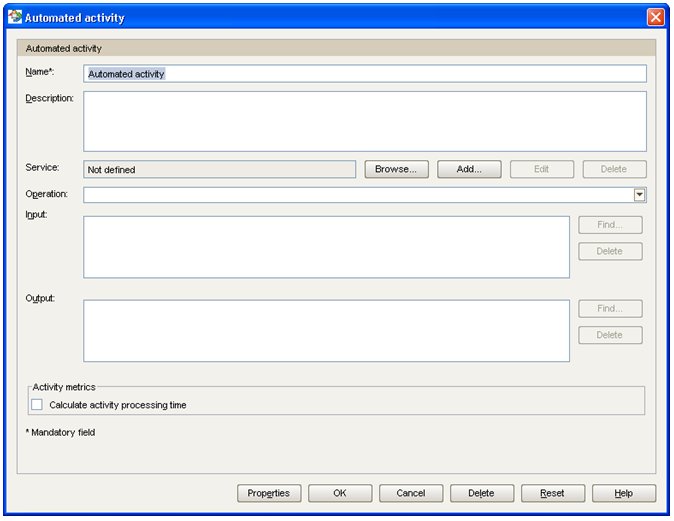Developing a solution to get from ARIS models to execution took some years and last week I presented some episodes from this time. As an example, I looked specifically at the development of Oracle BPA Suite, which includes an OEM version of different ARIS Platform products. Today, I want to give you some details about Oracle BPA Suite.
The vision of Oracle was to bridge the gap between business (ARIS as OEM product) and IT (existing Oracle development tools such as JDeveloper) based on shared metadata. The overall solution architecture is visualized in the following figure.
According to this solution architecture, the BPEL level in ARIS should play the role of the reconciliation layer between business and IT. Together with Oracle, we agreed upon three development phases:
- Rebranding and first data integration
- Round-trip synchronization and other added-value functionality
- Shared Repository
The first release of Oracle BPA Suite 10.1.3.3 was in September 2007, based on ARIS 7.02. The BPA Suite (or short OBPA) contained the following rebranded IDS Scheer products:
- ARIS Business Architect
- ARIS SOA Architect
- Parts of the ARIS UML Designer
- ARIS Business Simulator
- ARIS Business Server
- ARIS Business Publisher
Additionally, OBPA has an extended methodology and of course new, Oracle specific, functionality. The following figure shows new objects available in process models.
With the new object types, a supporting UI was introduced to assist the user regarding the special complex modeling conventions. For example, the following figure shows an OBPA specific dialog to specify details of an automated activity.
Other new features in the first version of OBPA were a service-oriented validation, a BPMN to BPEL transformation and a BPEL Import/Export framework.
With the next release, version 10.1.3.4., a round-trip functionality between business modeling and implementation tool was implemented. It was the very first product I know able to offer such a close business and IT alignment.
Of course even with this round-trip support the vision remains, that business rules IT and not vice versa. We had very tough discussions with Oracle product management, because they wanted to propagate changes done by developers on BPEL level automatically to the business process level in OBPA. It took quite some time to convince them, that the business department is responsible for the processes, not IT. But we have to excuse them, their background is development and IT and so they naturally tend to this IT near view. Finally, we implemented a macro that checks if there are changes done on BPEL level, informs the user about these changes and gives him the choice if he wants to propagate the changes into the business processes.
If now someone asks, why such a round-trip support is not part of ARIS SOA Architect, the answer is quite simple. ARIS SOA Architect follows a generic approach, all platforms able to import BPEL are target platforms. To establish a bi-directional synchronization between ARIS and other tools, special rules of the game have to be kept by both tools. For example, it has to be defined, who is master of what artifacts and how conflicting changes have to be resolved or merged. There is no standard defining such rules in a generic way and so round-trip support can only be implemented if both tool vendors are working closely together as we did with Oracle.
Other new features in OBPA 10.1.3.4 were the next version of the supporting UI (2.0) and BPMN simulation.
At the moment, we are working on the release of BPA Suite 11g bringing a set of changes and new functionality:
- Migration of all features to ARIS 7.1 technology (former versions of OBPA were based on ARIS 7.02)
- Supporting UI 3.0
- UDDI / WSIL Service Registry Support
- Oracle Identity Management Integration (Authentication; user and roles import)
- Simulation Scenario Enhancements
Also with this version Oracle migrated to the BEA based technology and infrastructure (e.g application server).
Looking back on the development of Oracle BPA Suite shows that just a rebranded version of ARIS products were turned into a tightly integrated solution. Next time I will show you how Oracle BPA Suite and generic ARIS Platform products play together.






